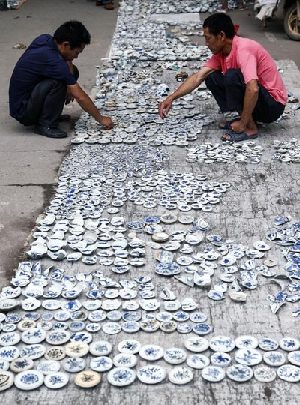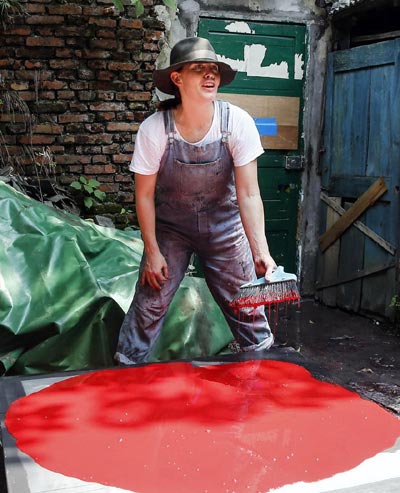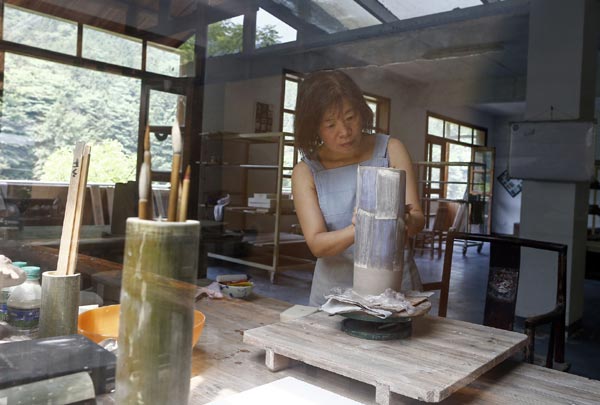Global commodity
 |
During the Song Dynasty (960-1279), potters in the city discovered the secret of making porcelain when they added kaolin to the China stone - a feldspar-rich form of granite - used in the production of pottery, and raised the temperatures in their kilns to 1,300 C and higher. The discovery led to the city being named after the era name of the emperor of the time, Jingde.
The resulting material was strong, translucent and brilliantly white, which facilitated the production of elaborate vessels with unparalleled potential for decoration, and for which there was unprecedented demand.
As one of the first and the most-important global commodities, porcelain helped to introduce Chinese culture, art and the name of Jingdezhen to the world, and it is still a pillar industry and symbol of the city.
Although the city has many modern ceramic factories, the ancient kilns have been well-preserved, and customers can purchase porcelain fired in 300-year-old wooden kilns, built during the Qing Dynasty (1644-1911).
In her studio at Sanbao, Yeung patiently polished a cylindrical vessel while blocks of clay were flattened with rolling pins, potters' wheels whirred, and completed works were brushed with a glaze. A stream runs outside the studio, which is set against a backdrop of leafy mountains, and the sound of the water hammers reminds visitors that China stone is still being broken down in the studio, where clay is still made in accordance with ancient methods.
Later, Yeung draw a series of small holes around the rim of a plate she was making - a design inspired by the lotus root, which resembles an old-fashioned telephone dial.
Born and raised in Hong Kong, Yeung said her residency in Jingdezhen is part of a voyage of discovery into her roots. "In Jingdezhen, I can focus on my pottery and really experience the ceramic tradition and Chinese culture," she said.
Sanbao plays host to more than 100 foreign artists every year, according to Li Wenying, the institute's manager. In 2004, when Jingdezhen celebrated its 1,000 anniversary, more than 3,000 foreign artists visited the institute to pay homage to the famous ceramics industry.
 |
|
At the antiques market in Jingdezhen, Jiangxi province. The market opens every Monday morning around 4 am, and is one of the largest of its kind in the city. Zhang Hao / China Daily |
Li said a large number of foreign potters have settled in the city in the past decade, and the area around Sanbao boasts more than 100 foreign-owned ceramic studios.
"Jingdezhen is a hub for ceramic arts," Li said. "Artists have access to every material they could want, and by communicating with the world-class artists here, people inspire each other. That's why we have great works in Jingdezhen."
Last year, the city's Ancient Kiln and Folk Customs Museum received 58 groups of foreign tourists, and 60 percent of overseas visitors to Jiangxi visited Jingdezhen's ancient kilns.
"I am delighted to see that the ancient pottery-making skills haven't died out," said Jerzy Mazur, who owns a ceramics studio in the United Kingdom.
For Lee Kyung-yoon, a 25-year-old Korean student at the Jingdezhen Ceramics Institute, the city is a perfect place to start his career.
"My father has been running a china store for more than 30 years in Icheon, the porcelain capital of South Korea. He said Jingdezhen is the most famous porcelain city in the world, and told me I must come here," he said.
Now Lee has become a sophisticated potter and is learning to make the blue and white porcelain for which Jingdezhen is famous. When he graduates, Lee, who enjoys painting landscape views on his ceramic work, will help his father run the family business.
"Jingdezhen is a much smaller city than Beijing or Shanghai," he said. "But my father is happy that I'm studying here because there is no place to have fun, there's only ceramics, ceramics and more ceramics!"
 |
|
China De La Vega, an Australian potter and painter, enjoys life and work in Jingdezhen. Zhang Hao / China Daily |
The institute has been recruiting international students since 2006, according to Hu Wei, head of the International Communication Department, who said the school provides three-month exchange programs that offer bachelor's, master's and doctoral degrees in ceramics and related studies.
 |
As one of very few institutes in China devoted to ceramics, the school is attracting an increasing number of international students, according to Hu. "Many artists and pottery lovers come here because of Jingdezhen's fame. Some of them apply to teach English in our school, and in return we let them join our ceramic classes," he said, adding that although the city's fame rests on its ancient porcelain arts, modern ceramics are not ignored.
Oldest and best
Tran Suc Linh, a 24-year-old sophomore from Vietnam, is studying chemistry and ceramic materials in Jingdezhen. "In Vietnam, we only have about a dozen glazes, but in Jingdezhen, I have discovered hundreds of them," said Linh, whose family owns a ceramics factory. "Everyone in this industry knows that Jingdezhen's porcelain is not only the oldest, but also the best. You can find every material, skill and piece of equipment this business requires in this city."
According to Li Jianshen, Sanbao's founder and an acclaimed ceramic artist in his own right, as a global commodity, porcelain is international and universal. People can understand its beauty despite the language barrier and cultural differences, and that's why porcelain and Jingdezhen attract so many people from outside China.
He said people have an instinctive impulse to play with mud and to make things. They don't have to understand Chinese to understand Chinese porcelain.
"Jingdezhen was the place where the most brilliant potters were found, and they developed an instinct into an art," he said. "It's like when people love classical music, they visit Europe. But if you make porcelain, you come to Jingdezhen."
 |
|
Yuk Kan Yeung is spending more than four weeks as artist in residence at the Sanbao Ceramic Art Institute in Jingdezhen. Zhang Hao / China Daily |
